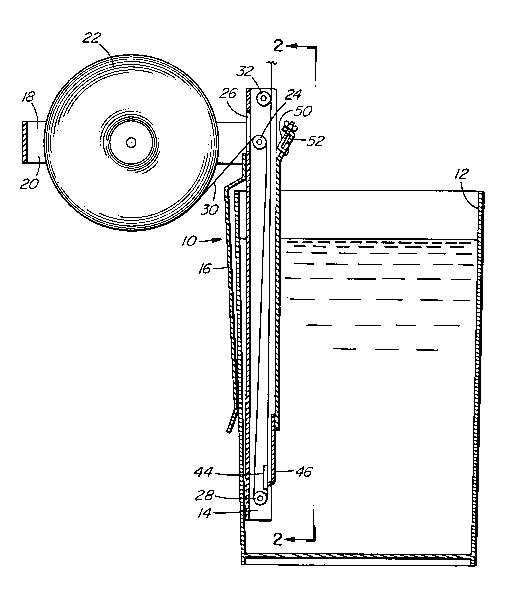Une partie des informations de ce site Web a été fournie par des sources externes. Le gouvernement du Canada n'assume aucune responsabilité concernant la précision, l'actualité ou la fiabilité des informations fournies par les sources externes. Les utilisateurs qui désirent employer cette information devraient consulter directement la source des informations. Le contenu fourni par les sources externes n'est pas assujetti aux exigences sur les langues officielles, la protection des renseignements personnels et l'accessibilité.
L'apparition de différences dans le texte et l'image des Revendications et de l'Abrégé dépend du moment auquel le document est publié. Les textes des Revendications et de l'Abrégé sont affichés :
| (12) Brevet: | (11) CA 2013439 |
|---|---|
| (54) Titre français: | DISPOSITIF DE FIXATION DE CONTENANT POUR APPLICATION DE PLATRE OU DE CIMENT SUR UN RUBAN |
| (54) Titre anglais: | CONTAINER ATTACHMENT DEVICE FOR APPLYING PLASTER OR CEMENT TO A TAPE |
| Statut: | Durée expirée - au-delà du délai suivant l'octroi |
| (51) Classification internationale des brevets (CIB): |
|
|---|---|
| (72) Inventeurs : |
|
| (73) Titulaires : |
|
| (71) Demandeurs : |
|
| (74) Agent: | BORDEN LADNER GERVAIS LLP |
| (74) Co-agent: | |
| (45) Délivré: | 1996-10-08 |
| (22) Date de dépôt: | 1990-03-29 |
| (41) Mise à la disponibilité du public: | 1991-09-29 |
| Requête d'examen: | 1991-06-20 |
| Licence disponible: | S.O. |
| Cédé au domaine public: | S.O. |
| (25) Langue des documents déposés: | Anglais |
| Traité de coopération en matière de brevets (PCT): | Non |
|---|
| (30) Données de priorité de la demande: | S.O. |
|---|
A container attachment device for applying
plaster or cement to a tape passes the tape through a pail
of wet cement or plaster and has a doctor blade to control
the thickness and evenness of the wet cement on the tape.
The device comprises an elongate housing having a clip to
engage the side of a pail or the like adapted to contain
wet cement or the like, the housing extending into the
interior of the pail. An arm extends outwards from a top
portion of the housing above the clip. The arm has a
support adapted to hold a roll of tape. Rollers are
provided on the elongate body for guiding tape from the
roll down to the lower end of the elongate housing in the
pail, and upwards out of the pail, and the doctor blade
ensures that an even thickness of wet cement or the like
is applied to the tape before leaving the pail.
Note : Les revendications sont présentées dans la langue officielle dans laquelle elles ont été soumises.
Note : Les descriptions sont présentées dans la langue officielle dans laquelle elles ont été soumises.

2024-08-01 : Dans le cadre de la transition vers les Brevets de nouvelle génération (BNG), la base de données sur les brevets canadiens (BDBC) contient désormais un Historique d'événement plus détaillé, qui reproduit le Journal des événements de notre nouvelle solution interne.
Veuillez noter que les événements débutant par « Inactive : » se réfèrent à des événements qui ne sont plus utilisés dans notre nouvelle solution interne.
Pour une meilleure compréhension de l'état de la demande ou brevet qui figure sur cette page, la rubrique Mise en garde , et les descriptions de Brevet , Historique d'événement , Taxes périodiques et Historique des paiements devraient être consultées.
| Description | Date |
|---|---|
| Inactive : Périmé (brevet - nouvelle loi) | 2010-03-29 |
| Inactive : CIB de MCD | 2006-03-11 |
| Inactive : CIB de MCD | 2006-03-11 |
| Accordé par délivrance | 1996-10-08 |
| Demande publiée (accessible au public) | 1991-09-29 |
| Toutes les exigences pour l'examen - jugée conforme | 1991-06-20 |
| Exigences pour une requête d'examen - jugée conforme | 1991-06-20 |
Il n'y a pas d'historique d'abandonnement
| Type de taxes | Anniversaire | Échéance | Date payée |
|---|---|---|---|
| TM (brevet, 8e anniv.) - petite | 1998-03-30 | 1998-03-24 | |
| TM (brevet, 9e anniv.) - petite | 1999-03-29 | 1999-03-22 | |
| TM (brevet, 10e anniv.) - petite | 2000-03-29 | 2000-03-21 | |
| TM (brevet, 11e anniv.) - petite | 2001-03-29 | 2001-03-06 | |
| Annulation de la péremption réputée | 2003-03-31 | 2002-02-11 | |
| TM (brevet, 12e anniv.) - petite | 2002-03-29 | 2002-02-11 | |
| Annulation de la péremption réputée | 2003-03-31 | 2003-03-28 | |
| TM (brevet, 13e anniv.) - petite | 2003-03-31 | 2003-03-28 | |
| 2004-03-29 | |||
| TM (brevet, 14e anniv.) - petite | 2004-03-29 | 2004-03-29 | |
| TM (brevet, 15e anniv.) - petite | 2005-03-29 | 2005-02-11 | |
| 2005-02-11 | |||
| 2005-10-17 | |||
| TM (brevet, 16e anniv.) - petite | 2006-03-29 | 2005-10-17 | |
| 2006-11-02 | |||
| TM (brevet, 17e anniv.) - petite | 2007-03-29 | 2006-11-02 | |
| TM (brevet, 18e anniv.) - générale | 2008-03-31 | 2007-12-07 | |
| TM (brevet, 19e anniv.) - générale | 2009-03-30 | 2008-11-13 |
Les titulaires actuels et antérieures au dossier sont affichés en ordre alphabétique.
| Titulaires actuels au dossier |
|---|
| MELVIN L. OVENS |
| WAYNE D. KORPA |
| Titulaires antérieures au dossier |
|---|
| S.O. |